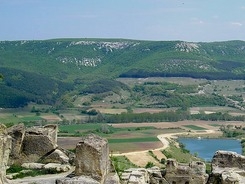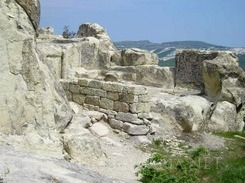Over one billion euro has been invested in the wellness and spa industry in Bulgaria over the past more...
| Search | Hotels / Accommodation | Vacations | Tours & Trips | Rent A Car | Transport | Flights | Conferences | Press Centre | Yachting |
- Hotels & Accommodation in Kardjali



- Glavatarski Han Hotel
- Perperikon Hotel
- Ustra Hotel


- Arpezos Hotel
- Perpera Villa Complex
- Nearby hotels



- Villa Ustra

- Kardjali Guide
- Early booking in Kardjali
- All inclusive in Kardjali
- Last minute in Kardjali
- Hotels in Kardjali
- Apartments in Kardjali
- Villas in Kardjali
- Rural houses in Kardjali
- Vacations in Kardjali
- Transport To Kardjali
- Tours in Kardjali
- Conferences in Kardjali
- Articles on Kardjali
- News From Kardjali
- Holidays in Bulgaria
- All inclusive
- Beach
- Birdwatching
- Golf
- Health
- History
- Hunting
- Monasteries/ Religious
- Mountain biking
- Prom
- Rural
- Ski
- Spa & Wellness
- Trekking
- Water sports
- Weekend breaks
- Wine
- Conference
- Children Holidays
- Yachting
- Events
- Type of accommodation
- Hotels
- Apartments
- Villas
- Rural houses
- Destinations
- Aheloy
- Ahtopol
- Albena
- Apriltsi
- Arbanassi
- Asparuhovo
- Assenovgrad
- Bachkovo Monastery
- Balchik
- Bankya
- Bansko
- Banya (Karlovo)
- Banya (Razlog)
- Batak
- Beklemeto
- Belchin Bani
- Beli Iskar
- Belogradchik
- Berkovitsa
- Blagoevgrad
- Bodrost
- Bojichen
- Borovets
- Botevgrad
- Bourgas
- Bozhentsi
- Bratsigovo
- Brestovitsa
- Buzludja
- Byala
- Chepelare
- Cherepish Monastery
- Chernomorets
- Chiflik
- Devin
- Dimitrovgrad
- Dobarsko
- Dobrich
- Dobrinishte
- Dolna Banya
- Dospat
- Dryanovo
- Dupnitsa
- Dyuni
- Elena
- Elenite
- Elhovo
- Gabrovo
- Gela
- Golden Sands
- Gorna Oryahovitsa
- Gotse Delchev
- Govedartsi
- Grand Hotel Varna
- Harmanli
- Haskovo
- Haskovo Mineral Baths
- Hissarya
- Ivaylovgrad
- Kalofer
- Kamchia
- Kamen Bryag
- Kardjali
- Karlovo
- Kavarna
- Kazanlak
- Kiten
- Kom
- Koprivshtitsa
- Kosharitsa
- Kostenets
- Kostenkovtsi
- Kotel
- Kovatchevitsa
- Kranevo
- Kresna
- Kulinoto
- Kyustendil
- Lom
- Lovech
- Lozenets
- Lukovit
- Lyaskovets
- Madara
- Malko Tarnovo
- Malyovitsa
- Melnik
- Mezdra
- Momchilovtsi
- Montana
- Narechen Baths
- Near Golden Sands
- Nessebar
- Obzor
- Ognyanovo
- Osogovo
- Pamporovo
- Panagyurishte
- Panichishte
- Parshevitsa
- Pavel Banya
- Pavlikeni
- Pazardjik
- Pernik
- Petrich
- Pirdop
- Pleven
- Pliska
- Plovdiv
- Pomorie
- Pravets
- Preslav
- Primorsko
- Ravda
- Razgrad
- Razlog
- Ribaritsa
- Rila Monastery
- Riviera
- Rousse
- Rusalka
- Samokov
- Sandanski
- Sapareva Banya
- Semkovo
- Sevlievo
- Shabla
- Shipka
- Shipkovo
- Shiroka Laka
- Shkorpilovtsi
- Shoumen
- Silistra
- Sinemorets
- Sliven
- Smolyan
- Sofia
- Sopot
- Sozopol
- Srebarna
- St. Constantine & Elena
- Stara Zagora
- Starozagorski Baths
- Sunny Beach
- Sunny Day
- Sveti Vlas
- Svilengrad
- Svishtov
- Targovishte
- Teteven
- Tran
- Trigrad
- Troyan
- Tryavna
- Tsarevo
- Tsigov Chark
- Uzana
- Varna
- Varshets
- Veliko Tarnovo
- Velingrad
- Vidin
- Vitosha
- Voneshta Voda
- Vratsa
- Vratsata Gorge
- Yagoda
- Yakoruda
- Yambol
- Zlatitsa
- Zlatograd
- Bulgaria Guide
- General information
- Bulgarian Monasteries
- SPA Bulgaria
- The Black sea
- History
- Geography
- Maps
- Weather
- Airports in Bulgaria
- Webcams
- Forums
- Mountains in Bulgaria
- The Balkan Mountain Range
- Rila Mountain
- Pirin Mountain
- The Rodope Mountain
- Vitosha Mountain
- Travel Arrangements
- Visit Bulgaria
- Visa Requierments
- Choose Destination
- Flights to Bulgaria
- Transport in Bulgaria
- Advice
- Currency
- Official Holidays
Subscribe to newsletters to receive our hottest offers:
| Home > Kardjali > News |
Tatul Orpheus Shrine, more ancient than Egypt’s pyramids
Roumyana Tzvetkova, Daniela Konstantinova

The Orpheus Shrine near the village of Tatul in the Eastern Rhodopi Mountains, Southern Bulgaria, is more ancient than the Egyptian pyramids, evidence found during four years of archaeological research held by the team of Prof. Nikolay Ovcharov, suggests.
“This place originated as a point of worship six thousand years ago – at the end of the Copper Age in 4 millennium BC,” Prof. Ovcharov explains. “We presumed this but had no evidence.  Finally, however we came across a massive layer from the Stone Copper Age rich in finds, deer and boar sacrifices and a range of cult items. It seems that the rocks of Tatul’s hill housed a big building. We found large chunks from its adobe walls. So we can assert now that an ancient temple operated in the rocks six thousand years ago. We cannot say what was the cult it served in that period. But we can learn more about its Bronze Age priorities. We have dug out the total of 35 Bronze Age altars used for making sacrifices to gods. One of the altars is larger than the rest. It is made of very compact clay and was obviously the main altar of the shrine. It seems that in the 2 millennium BC, in the Middle and Late Bronze Age, the shrine in Tatul began to be associated with the legendary musician Orpheus. It was then that the process of carving into the rocks started. There were indeed temples in the Stone Copper Age, but they were arranged right into natural rocks and caves. The change that came with the Bronze Age was that carving rock spaces started. The truncated pyramid with the tomb is also dated to that time. It impresses all visitors of Tatul. We believe that this was Orpheus’s symbolical tomb. This trail leads us in time to the appearance of the magnificent shrine that everybody can relish today.”
Finally, however we came across a massive layer from the Stone Copper Age rich in finds, deer and boar sacrifices and a range of cult items. It seems that the rocks of Tatul’s hill housed a big building. We found large chunks from its adobe walls. So we can assert now that an ancient temple operated in the rocks six thousand years ago. We cannot say what was the cult it served in that period. But we can learn more about its Bronze Age priorities. We have dug out the total of 35 Bronze Age altars used for making sacrifices to gods. One of the altars is larger than the rest. It is made of very compact clay and was obviously the main altar of the shrine. It seems that in the 2 millennium BC, in the Middle and Late Bronze Age, the shrine in Tatul began to be associated with the legendary musician Orpheus. It was then that the process of carving into the rocks started. There were indeed temples in the Stone Copper Age, but they were arranged right into natural rocks and caves. The change that came with the Bronze Age was that carving rock spaces started. The truncated pyramid with the tomb is also dated to that time. It impresses all visitors of Tatul. We believe that this was Orpheus’s symbolical tomb. This trail leads us in time to the appearance of the magnificent shrine that everybody can relish today.”
The shrine is dated to 4-3 c. BC, the era of the celebrated rock tombs in the Thracian Valley. Its architecture and construction method take it close to the Kazanlak tombs, however it is also the first above—the-ground temple in Thrace, Prof. Ovcharov explains. Viewed from within, it resembles a castle perched on the rock, the archeologist adds. Cult practices in the Tatul shrine continued uninterrupted until the adoption of Christianity in the late 4 and early 5 c., when it was converted into a private estate and remained so until the end-12 c. Now that archaeological excavations have closed, European funding will go to conservation and restoration works.
The Orpheus Shrine is in close proximity to the holy stone city of the Thracians, Perperikon. It is the largest megalith in the Balkans stretching on an area of 12 sq. km. The city is made of a strong fortress wall, an acropolis, a palace hewn into the rocks and two suburbs. The first archeological finds in Perperikon this summer include two animal heads dated to 3-1 c. BC.
 “One of them is a dragon with an open mouth, a crest and adornments. The other find is part of a cobra head, a unique find,” Prof. Ovcharov says. “We know that the serpent is the guardian of the Earth’s womb – a cult directly linked to the Thracian god Dionysus. The finds belong to a Rhodope mountain culture named Tzepina. Tzepina is a stronghold in the Western Rhodopes where ceramic items of this kind were found for the first time. These are cult items. We have dug out vessels with cult scenes depicted on them,” concludes archaeologist Prof. Nikolay Ovcharov.
“One of them is a dragon with an open mouth, a crest and adornments. The other find is part of a cobra head, a unique find,” Prof. Ovcharov says. “We know that the serpent is the guardian of the Earth’s womb – a cult directly linked to the Thracian god Dionysus. The finds belong to a Rhodope mountain culture named Tzepina. Tzepina is a stronghold in the Western Rhodopes where ceramic items of this kind were found for the first time. These are cult items. We have dug out vessels with cult scenes depicted on them,” concludes archaeologist Prof. Nikolay Ovcharov.

















